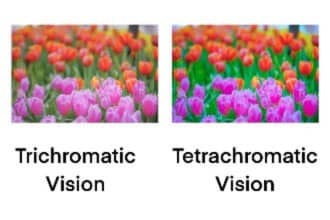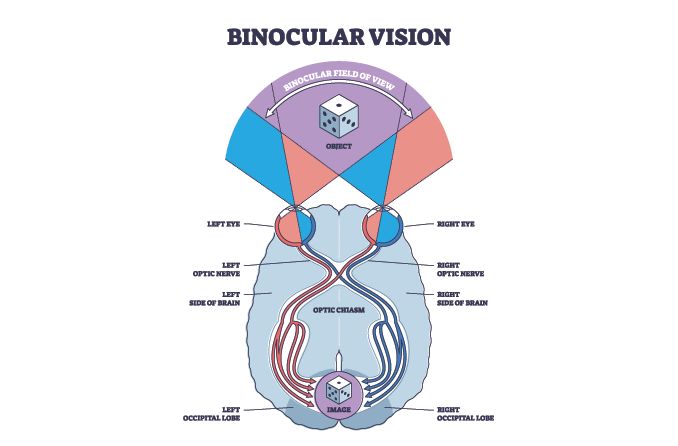What is tetrachromacy?
Tetrachromacy allows some people to see colors that are not visible to most others. It is a condition that results when an additional type of color receptor cell is present in the eye. Those who are tetrachromatic can perceive an estimated 100 million color variations.
With normal color vision, humans can see approximately one million different colors.
Tetrachromacy amplifies the eye’s ability to distinguish between shades of colors. This creates a visual result that some might call “super vision.” Tetrachromacy is a rare genetic phenomenon that is believed to only affect females. Up to 12% of women worldwide may be tetrachromatic.
The idea of some women being tetrachromatic first originated in 1948 by Dutch scientist (H. L.) de Vries. His hypothesis focused on the inherited factors of this condition. De Vries speculated tetrachromatic women were daughters of people with anomalous trichromacy.
Anomalous trichromacy is a type of congenital color blindness. All three cones are present, but one type doesn’t function properly. This condition prevents some people from being able to distinguish between certain colors.
How you see color
The retina is the light-sensitive structure in the back of the eye that allows it to sense light. It transmits signals to the brain via the optic nerve. Once these signals reach the visual areas of the brain, they are converted into images you “see.”
The retina contains special cells called photoreceptors that provide you with color vision. These photoreceptors consist of rods and cones. Rods allow the eye to sense light and see in the dark. Cones allow the eye to see and differentiate colors.
Types of cones in the human eye
There are three types of cones in the human eye: those that help you perceive blue, green and red. These cones have photopigments that absorb short, medium and long wavelengths of light. They allow you to see the three color categories listed above as well as the colors that fall in between.
People with normal color vision are “trichromatic” based on these three color dimensions. Most individuals have trichromatic color perception.
When tetrachromacy is present, there is a fourth category of cones in the retina. This extra group of cone cells is thought to allow the perception of a fourth color dimension. (“Tetra” comes from the Greek root for the number four and “chroma” means color.)
When cones are defective or missing, some form of color blindness results. People affected by color blindness can have “dichromatic,” “monochromatic” or anomalous trichromatic vision. The type of color blindness they have depends on the number or type of cone categories affected.
Causes of tetrachromacy
The gene related to color vision is on the X chromosome. Tetrachromacy is caused by a genetic mutation on this chromosome. Females have two X chromosomes (one inherited from the mother and one from the father).
As such, there is potentially a higher likelihood for women to have an anomalous gene for a fourth type of cone in the retina. Males have an X and a Y chromosome, decreasing the chance of tetrachromacy. In fact, males have a greater likelihood of being color blind for this reason.
Some researchers believe color blindness in a woman’s father or son raises the odds of having four cone types. They estimate that the milder the color blindness, the higher the chance of tetrachromacy in related females.
How to know if you’re tetrachromatic
Certain tests may help determine if a person is tetrachromatic, although genetic testing is the only conclusive test. These might involve giving the individual a series of separate but similar colors. They would then rate the degree of similarity on a particular scale. This approach may help determine how sensitive a person is to seeing differences in similar shades of color.
Other forms of testing for tetrachromacy might include color reproduction experiments. With this method, participants are given a series of colors in a palette. They are asked to reproduce each color by painting the exact shade. Researchers then compare each of the shades to the original set to see if there is any variation.
Several tests are available online to help individuals determine if they are tetrachromatic. There are significant limitations to this testing method, however. Computer screens and mobile devices may all display colors differently. This could cause the test results to be inaccurate.
Testing for tetrachromacy should be conducted by a professional. The only reliable way to confirm the presence of a fourth set of cones is through genetic testing.
Much of the research surrounding tetrachromacy involves two factors. The first is determining how having extra cones impacts color processing. The second centers on what role genetics play in color processing differences.
What’s it like to be tetrachromatic?

One can imagine tetrachromats see the world with more color vibrancy than most. Sensing even minor differences in shades may be useful to artists and those who work with color.
Concetta Antico is an artist with tetrachromacy. Having super color vision has enhanced her artwork in several ways. Being a tetrachromat allows her to use color in a manner that makes her work more dynamic.
There is also speculation that being tetrachromatic may allow some people to see subtle changes in skin color. This could be beneficial in detecting concerns that may indicate disease or other health issues.
It is unclear whether having tetrachromacy affects a person’s vision. Further research is needed to better understand this phenomenon.
READ NEXT: How far can the human eye see?










